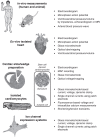25 years of basic and translational science in EP Europace: novel insights into arrhythmia mechanisms and therapeutic strategies
- PMID: 37622575
- PMCID: PMC10450791
- DOI: 10.1093/europace/euad210
25 years of basic and translational science in EP Europace: novel insights into arrhythmia mechanisms and therapeutic strategies
Abstract
In the last 25 years, EP Europace has published more than 300 basic and translational science articles covering different arrhythmia types (ranging from atrial fibrillation to ventricular tachyarrhythmias), different diseases predisposing to arrhythmia formation (such as genetic arrhythmia disorders and heart failure), and different interventional and pharmacological anti-arrhythmic treatment strategies (ranging from pacing and defibrillation to different ablation approaches and novel drug-therapies). These studies have been conducted in cellular models, small and large animal models, and in the last couple of years increasingly in silico using computational approaches. In sum, these articles have contributed substantially to our pathophysiological understanding of arrhythmia mechanisms and treatment options; many of which have made their way into clinical applications. This review discusses a representative selection of EP Europace manuscripts covering the topics of pacing and ablation, atrial fibrillation, heart failure and pro-arrhythmic ventricular remodelling, ion channel (dys)function and pharmacology, inherited arrhythmia syndromes, and arrhythmogenic cardiomyopathies, highlighting some of the advances of the past 25 years. Given the increasingly recognized complexity and multidisciplinary nature of arrhythmogenesis and continued technological developments, basic and translational electrophysiological research is key advancing the field. EP Europace aims to further increase its contribution to the discovery of arrhythmia mechanisms and the implementation of mechanism-based precision therapy approaches in arrhythmia management.
Keywords: Atrial fibrillation; Basic electrophysiology; Genetics; Ion channels; Modelling; Pathophysiology; Sudden cardiac death; Translational electrophysiology; Ventricular arrhythmias.
© The Author(s) 2023. Published by Oxford University Press on behalf of the European Society of Cardiology.
Conflict of interest statement
Conflict of interest: None declared.
Figures



Similar articles
-
German Cardiac Society Working Group on Cellular Electrophysiology state-of-the-art paper: impact of molecular mechanisms on clinical arrhythmia management.Clin Res Cardiol. 2019 Jun;108(6):577-599. doi: 10.1007/s00392-018-1377-1. Epub 2018 Oct 10. Clin Res Cardiol. 2019. PMID: 30306295 Review.
-
Interventional electrophysiology and its role in the treatment of cardiac arrhythmia.Ann Acad Med Singap. 1998 Mar;27(2):248-54. Ann Acad Med Singap. 1998. PMID: 9663319 Review.
-
Advanced electrophysiologic mapping systems: an evidence-based analysis.Ont Health Technol Assess Ser. 2006;6(8):1-101. Epub 2006 Mar 1. Ont Health Technol Assess Ser. 2006. PMID: 23074499 Free PMC article.
-
Arrhythmias and heart failure.Cardiol Clin. 2014 Feb;32(1):125-33, ix. doi: 10.1016/j.ccl.2013.09.005. Epub 2013 Oct 18. Cardiol Clin. 2014. PMID: 24286583 Review.
-
Future prospects of antiarrhythmic treatment based on experimental studies.Eur Heart J. 1995 Aug;16 Suppl G:2-6. doi: 10.1093/eurheartj/16.suppl_g.2. Eur Heart J. 1995. PMID: 8595794 Review.
Cited by
-
Evolution in electrophysiology 100 years after Einthoven: translational and computational innovations in rhythm control of atrial fibrillation.Europace. 2024 Dec 26;27(1):euae304. doi: 10.1093/europace/euae304. Europace. 2024. PMID: 39729032 Free PMC article. Review.
-
Safety and efficacy of long-term sodium channel blocker therapy for early rhythm control: the EAST-AFNET 4 trial.Europace. 2024 Jun 3;26(6):euae121. doi: 10.1093/europace/euae121. Europace. 2024. PMID: 38702961 Free PMC article. Clinical Trial.
-
2024 updated European Heart Rhythm Association core curriculum for physicians and allied professionals: a statement of the European Heart Rhythm Association of the European Society of Cardiology.Europace. 2024 Nov 1;26(11):euae243. doi: 10.1093/europace/euae243. Europace. 2024. PMID: 39298665 Free PMC article.
-
Electrophysiological tolerance: a new concept for understanding the electrical stability of the heart.Europace. 2024 Nov 1;26(11):euae282. doi: 10.1093/europace/euae282. Europace. 2024. PMID: 39487808 Free PMC article. Review.
-
GSTP1 inhibits angiotensin II-induced atrial fibrillation by regulating ferroptosis.Europace. 2025 May 7;27(5):euaf083. doi: 10.1093/europace/euaf083. Europace. 2025. PMID: 40186487 Free PMC article.
References
-
- Bhaskaran A, Chik W, Pouliopoulos J, Nalliah C, Qian P, Barry Tet al. . Five seconds of 50–60 W radio frequency atrial ablations were transmural and safe: an in vitro mechanistic assessment and force-controlled in vivo validation. Europace 2017;19:874–80. - PubMed
-
- Franceschi F, Bonan R, Khairy P, Dubuc M, Thibault B, Macle Let al. . Histopathological effects and evolution of transvenous β-radiation applications in right and left atria: an animal study. Europace 2012;14:745–51. - PubMed
-
- Tofig BJ, Lukac P, Nielsen JM, Hansen ESS, Tougaard RS, Jensen HKet al. . Radiofrequency ablation lesions in low-, intermediate-, and normal-voltage myocardium: an in vivo study in a porcine heart model. Europace 2019;21:1919–27. - PubMed
Publication types
MeSH terms
Substances
Grants and funding
LinkOut - more resources
Full Text Sources
Medical
Miscellaneous

